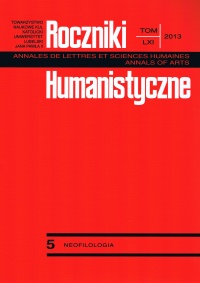Blogging as an Extensive Tool for English Phraseology Acquisition: Teaching the Semantic Aspect of Idioms with Blogs
Abstrakt
Blogging jako wielostronne narządzie w akwizycji angielskiej frazeologii. Nauczanie semantycznych aspektów idiomów za pomocą blogów
Artykuł omawia zastosowanie nowych metod w nauczaniu pewnych aspektów frazeologii (ze szczególnym uwzględnieniem specyfiki idiomów), bazując na nowoczesnych aplikacjach i urządzeniach. Główną metodą jest nauczanie idiomów za pomocą Internetu. Właściwym jest podejście, które pozwala rozwinąć zdolności oraz autonomię studenta. Korzystając z nowoczesnych rozwiązań technologicznych, nauczanie zyskuje nowy, bardziej interesujący, przystępny wymiar. Staje się dynamiczne, angażuje uwagę studenta, który nawet nie zauważa, że skomplikowane struktury frazeologiczne, wyrażenia idiomatyczne, są nabywane naturalnie, w trakcie wykonywanych ćwiczeń. Interaktywny wymiar zadań sprzyja rozwinięciu kompetencji lingwistycznych, komunikacji, zwiększa poziom krytycznej kreatywności. Teleinformatyczne narzędzia dynamizują strukturę poznawczą. Student otrzymuje możliwe podpowiedzi dzięki programom komputerowym. Daną frazę, w szczególności idiom, uczy się sytuować w odpowiednim kontekście, a efektywność prawidłowego wykonywania zadań wzrasta z 60% do 90%. Student prowadzi własny blog, udziela się na blogach innych studentów, aby stosować frazeologię języka angielskiego w życiu codziennym. Projekt związany z prowadzeniem blogów przez studentów aktywizuje ich słownik, dzięki czemu aktywnie używają zwrotów frazeologicznych, idiomów. Blogi zachęcają do poznawania języka, rozumienia semantyki, osadzają frazy w szerszym kontekście. Po zakończeniu nauki większość studentów nadal prowadzi swoje blogi, co zresztą jest zrozumiałe, skoro blog jest współczesną, powszechną formą komunikacji.
Bibliografia
Agar, M.H. 1994. Language Shock: Understanding the culture of conversation. New York: William Morrow and Company, Inc.
Al-Seghayer, K. 2001. “The effects of multimedia annotation modes on L2 vocabulary acquisition: a comparative study” in Language Learning and Technology, Vol. 5, No. 1, 202-232.
Alemi, M. and P. Daftarifard. 2010. “Pedagogical Innovations in Language Teaching Methodologies” in Journal of Language Teaching and Research, Vol. 1, No 6, 765-770.
Atay, D. and C. Ozbulgan. 2007. “Memory strategy instruction, contextual learning and ESP vocabulary recall” in English for Specific Purposes, Vol. 26, 39-51.
Bangs, P. and P. Cantos. 2004. “What can Computer Assisted Language Learning Contribute to Foreign Language Pedagogy?” in International Journal of English Studies, Vol. 1, 221-239.
Barbieri, K., H. Doerr, and D. Dwyer. 1995. Creating a Virtual Classroom for Interactive Education on the Web. The Third International World Wide Web Conference. (http://www.igd.fhg.de/www/www95/ – accessed 17th November 2012).
Brown, J.D. 1998. “Computers in language testing: Present research and some future directions” in Language Learning & Technology, 1(1), 44-59.
Chun, D.M. and J.L. Plass. 1997. “Research on text comprehension in multimedia environments” in Language Learning and Technology, Vol. 1, No. 1, 60-81.
Creswell, J.W. 1994. Research Design: Qualitative and Quantitative Approaches. London: SAGE Publications.
Cohen, L. and L. Manion. 1980. Research Methods in Education. London: Groom Helm Ltd.
Ducate, L. and N. Arnold. 2006. “Future foreign language teachers’ social and cognitive collaborations in an online environment” in Language Learning and Technology, Vol. 10, No. 1, 42-66.
Horst, M., T. Cobb, and I. Nicolae. 2005. “Expanding academic vocabulary with an interactive on-line database” in Language Learning and Technology, Vol. 9, No. 2, 90-110.
Hussey, J. and R. Hussey. 1997. Business research: A practical guide for undergraduate and post graduate students. London: Macmillan Press LTD.
Klickaya, F. and J. Krajka. 2010. “Comparative usefulness of online and traditional vocabulary learning” in TOJET: The Turkish Online Journal of Educational Technology, Vol. 9 Issue 2, 55-63.
Kramsch, C. 1998. Language and Culture. Oxford: Oxford University Press.
Lee, L. 2011. “Blogging: promoting learner autonomy and intercultural competence through study abroad” in Language Learning and Technology, Vol. 15, No. 3, 87-109.
Leu, D. 2000. “Literacy and technology: Deictic consequences for literacy education in an information age”. In M. Kamil, P. Mosenthal, P. Pearson & R. Barr, (Eds.), Handbook of reading research: Volume III (pp. 743-770). Mahwah, NJ: L. Erlbaum Associates.
Leu, D., and C. Kinzer. 2000. “The convergence of literacy instruction with networked technologies for information and communication” Reading Research Quarterly, 35 (1), 108-127.
Loucky, J.P. 2006. “Maximizing Vocabulary Development by Systematically Using a Depth of Lexical Processing Taxonomy, CALL Resources, and Effective Strategies” in CALICO Journal, 23 (2), 363-399.
Noblitt, J.S. and S.K. Bland. 1991. “Tracking the learner in computer-aided language learning” in B. Freed (Ed.), Foreign Language Acquisition Research and the Classroom (120-131). Lexington, MA: D. C. Heath and Company.
Ma, Q, and P. Kelly. 2006. “Computer Assisted Vocabulary Learning: Design and evaluation” in Computer-Assisted Language Learning, Vol. 19, No. 1, 15-45.
Paivio, A. 2006. Mind and its evolution; A dual coding theoretical interpretation, Mahwah, NJ: Lawrence Erlbaum Associates, Inc.
Payne, J.S. and S.L. Thorne. 2005. “Evolutionary Trajectories, Internet-mediated Expression, and Language Education” in CALICO Journal, 22 (3), 371-397.
Pazio, M. 2010. “Blended learning and its potential in expanding vocabulary language: a case study” in Teaching Englih with technology, Vol. 10, No. 1, 3-30.
Piirainen, E. 2008. “Figurative phraseology and culture”. In: Granger S., and F. Meunier (eds.) Phraseology: an interdisciplinary perspective.
Richardson, W. 2006. Blogs, Wikis, Podcasts, and Other Powerful Web Tools for Classrooms. California: Corwin Press.
Sandholtz, J.H., C. Ringstaff, and D.C. Dwyer. 1997. Teaching with technology: Creating student-centered classrooms. New York: Teachers College Press.
Wible, D. 2008. “Multiword expressions and the digital turn”. In: F. Meunier and S. Granger (eds.) Phraseology in foreign language learning and teaching.
Copyright (c) 2013 Roczniki Humanistyczne

Utwór dostępny jest na licencji Creative Commons Uznanie autorstwa – Użycie niekomercyjne – Bez utworów zależnych 4.0 Międzynarodowe.





